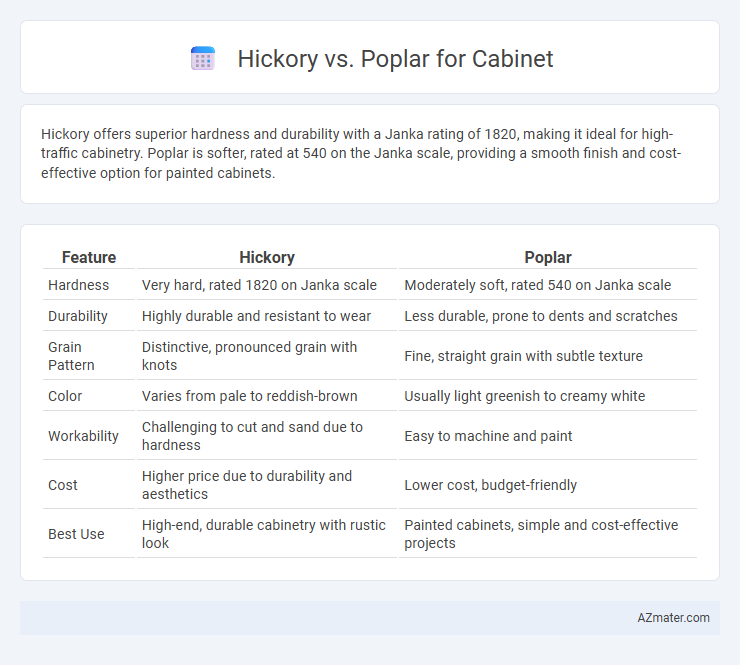Hickory offers superior hardness and durability with a Janka rating of 1820, making it ideal for high-traffic cabinetry. Poplar is softer, rated at 540 on the Janka scale, providing a smooth finish and cost-effective option for painted cabinets.
Table of Comparison
| Feature | Hickory | Poplar |
|---|---|---|
| Hardness | Very hard, rated 1820 on Janka scale | Moderately soft, rated 540 on Janka scale |
| Durability | Highly durable and resistant to wear | Less durable, prone to dents and scratches |
| Grain Pattern | Distinctive, pronounced grain with knots | Fine, straight grain with subtle texture |
| Color | Varies from pale to reddish-brown | Usually light greenish to creamy white |
| Workability | Challenging to cut and sand due to hardness | Easy to machine and paint |
| Cost | Higher price due to durability and aesthetics | Lower cost, budget-friendly |
| Best Use | High-end, durable cabinetry with rustic look | Painted cabinets, simple and cost-effective projects |
Introduction to Hickory and Poplar Woods
Hickory wood is renowned for its exceptional hardness, density, and durability, making it a preferred choice for cabinets that require strength and resistance to wear. Poplar wood, by contrast, is a softer hardwood known for its smooth grain and ease of painting, making it ideal for cabinets that demand a versatile, cost-effective material. Both hickory and poplar offer unique characteristics that influence their suitability in cabinetry based on desired aesthetics and functional requirements.
Visual Differences: Grain and Color Comparison
Hickory cabinets display a bold and distinctive grain pattern with dramatic color contrasts, featuring rich browns, creamy whites, and occasional reddish streaks that create a rustic and textured appearance. Poplar, in contrast, offers a smoother, more uniform grain with a subtle, often pale green or yellowish hue that lends itself well to painted finishes and a cleaner, softer look. The striking natural variations in hickory make each cabinet unique, while poplar provides a more consistent and versatile color palette ideal for contemporary or traditional cabinetry.
Durability and Strength: Hickory vs Poplar
Hickory cabinets offer superior durability and strength, making them ideal for high-traffic areas and heavy-use environments due to their dense grain and hardness rating of 1820 on the Janka scale. Poplar, with a lower Janka hardness of around 540, is softer and more prone to dents and scratches, which limits its suitability for durability-focused cabinetry. Choosing hickory ensures long-lasting performance and resistance to wear, while poplar is better suited for decorative or lightly used cabinet components.
Workability and Ease of Machining
Hickory cabinets offer exceptional workability due to their density and strength but can be challenging to machine because of their hardness, often requiring sharp tools and slower feed rates. Poplar is significantly easier to machine and shape, making it ideal for detailed cabinetry work, while also providing good workability with fewer tool wear concerns. Both woods finish well, but poplar's softer nature enhances overall ease of fabrication and assembly in cabinet construction.
Cost and Availability
Poplar is generally more affordable and widely available than hickory, making it a popular choice for budget-conscious cabinet projects. Hickory tends to be more expensive due to its hardness and unique grain patterns, which also influences its availability in some regions. Both woods are commonly stocked by lumber suppliers, but poplar's consistent supply and lower cost give it a clear advantage for large-scale or cost-sensitive cabinetry.
Finishing and Staining Potential
Hickory cabinets offer a high-density grain that absorbs stains unevenly, creating a naturally rustic and variegated finish ideal for achieving a distressed or antique look. Poplar wood provides a smoother surface with a uniform grain, making it highly receptive to paint and stains for consistent, vibrant color results. While hickory's finishing highlights its rugged character, poplar excels in versatility, allowing for more controlled and predictable staining outcomes in cabinetry.
Environmental Impact and Sustainability
Hickory and poplar both offer different environmental footprints for cabinet construction, with hickory being a hardwood that grows slower and often harvested from mature forests, potentially leading to greater ecological impact. Poplar, a fast-growing hardwood species, is considered more sustainable due to its rapid replenishment rate and widespread availability, reducing deforestation pressures. Choosing poplar cabinets supports environmentally responsible forestry practices and lower carbon emissions compared to hickory, making it a greener choice for eco-conscious consumers.
Best Applications in Cabinetry
Hickory is ideal for cabinetry requiring exceptional durability and a rustic, natural appearance due to its hardness and prominent grain patterns. Poplar offers a smooth, paint-friendly surface perfect for painted cabinets and budget-conscious projects because of its affordability and uniform texture. Both woods excel in cabinetry, with hickory best suited for high-traffic kitchens and poplar preferred for decorative or painted finishes.
Pros and Cons of Hickory for Cabinets
Hickory cabinets are prized for their exceptional hardness and durability, making them highly resistant to dents and scratches, ideal for high-traffic kitchen environments. The wood's distinctive grain pattern and color variation add a rustic and visually striking appeal, yet this natural inconsistency may require more careful planning to achieve a uniform finish. Despite its robustness, hickory is heavier and harder to work with than softer woods like poplar, potentially increasing labor costs and construction time.
Pros and Cons of Poplar for Cabinets
Poplar is an affordable, lightweight hardwood with a smooth texture that makes it easy to paint, offering versatility for cabinet designs. It is less durable and less wear-resistant compared to Hickory, making it prone to dents and scratches over time. Poplar's inconsistent grain and softer nature limit its suitability for high-traffic or heavy-use cabinets but provide an excellent surface for a painted finish in low-traffic areas.

Infographic: Hickory vs Poplar for Cabinet
 azmater.com
azmater.com